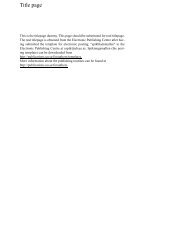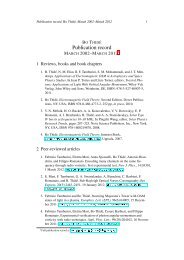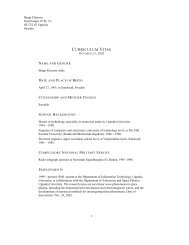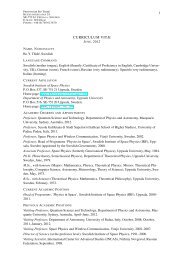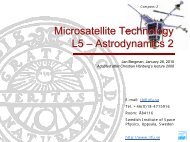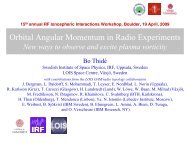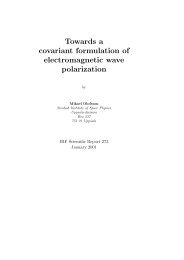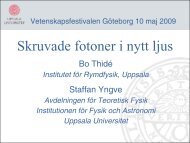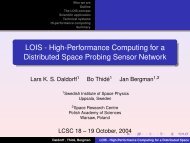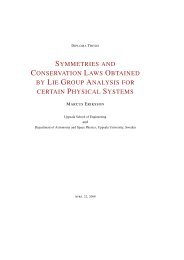Atmosphere-Ionosphere Mission - Swedish Institute of Space ...
Atmosphere-Ionosphere Mission - Swedish Institute of Space ...
Atmosphere-Ionosphere Mission - Swedish Institute of Space ...
You also want an ePaper? Increase the reach of your titles
YUMPU automatically turns print PDFs into web optimized ePapers that Google loves.
TECHNOLOGY 19<br />
in fast, large on-board buffer memories before transmitting them to the ground,<br />
allows after-the-fact analyses <strong>of</strong> signals <strong>of</strong> relatively long duration.<br />
Using this data taking paradigm, signals with all their characteristics can, at any<br />
time after their detection and recording, be recreated in s<strong>of</strong>tware. Such s<strong>of</strong>tware<br />
has already been developed. This is an invaluable advantage which maximises the<br />
usefulness <strong>of</strong> the data and the flexibility <strong>of</strong> the observations. However, this technique<br />
also puts heavy demands on the on-board detectors. The analogue-to-digital<br />
converters (ADCs) used must be fast enough to cope with the natural resonance<br />
frequencies <strong>of</strong> the space plasma under study (several MHz). On the other hand,<br />
due to the limitations <strong>of</strong> a micro/nano-satellite system, the ADCs must not consume<br />
too much electric power and the energy budget must be met. Furthermore,<br />
they must be able to handle small signals in the presence <strong>of</strong> large signals without<br />
introducing instrumental distortion (i.e., have good two-signal selectivity) which<br />
could be mistaken for a true physical effect or even swamp the detector system<br />
completely.<br />
Currently, the state-<strong>of</strong>-the-art ADCs which are fast enough seem to be limited<br />
to 14 bit linear quantisation (84 dB dynamic range) while nature requires something<br />
<strong>of</strong> the order 16–18 bits (96–108 dB dynamic range). With the current rapid<br />
development <strong>of</strong> ADCs, we expect low-power chips with this higher performance to<br />
become available in the near future. In the meantime, we have used 14 bit samplers<br />
in our prototypes to verify the functionality <strong>of</strong> the measurement technique and algorithms<br />
used. In an actual experiment, for obtaining full information on the waves<br />
observed, one would need one sampling channel per component <strong>of</strong> the electric and<br />
magnetic fields, i.e., six channels. At this time <strong>of</strong> writing (September 2002), we<br />
have three complete, fully functional, tested and calibrated three-channel, 14-bit<br />
receiver ready and now want to go ahead with the production <strong>of</strong> five flight-design<br />
miniaturised versions <strong>of</strong> these receivers to be fit for an actual satellite mission. The<br />
prototyping <strong>of</strong> the telemetry transceiver and the non-shadowed telemetry antenna<br />
has been finished.<br />
3.2 Efficient small antennas for high-frequency (HF) radio waves<br />
For maximum signal-to-noise ratio, an antenna for an HF electric field should<br />
preferably be <strong>of</strong> the order half a wavelength <strong>of</strong> the wave received or longer. In<br />
the case <strong>of</strong> electromagnetic waves at typical ionospheric and magnetospheric resonance<br />
frequencies this would mean prohibitively long antennas (many tens <strong>of</strong><br />
metres) if standard conductor antennas are used. However, as is well-known from<br />
elementary antenna theory, short dipoles operate just as well as full-sized half-wave<br />
ones when it comes to directivity/antenna pattern. The main drawback <strong>of</strong> electrically<br />
short antennas is their highly reactive and very low resistive feed impedance, a<br />
complication which can be partly solved by adding good pre-amplifiers. Using material<br />
and geometries where the effective dielectric constant is large, the physical<br />
length will be shorter than the electric length. We are now entering the process <strong>of</strong><br />
constructing physically short but electrically longer antennas with pre-amplifiers<br />
<strong>Atmosphere</strong>-<strong>Ionosphere</strong> <strong>Mission</strong><br />
Elaborate Science Case



